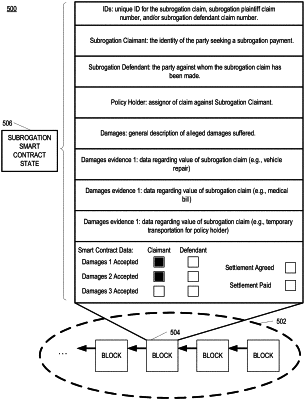| CPC G06Q 40/08 (2013.01) [G06N 20/00 (2019.01); G07C 5/008 (2013.01); G07C 5/0816 (2013.01); G07C 5/0866 (2013.01); H04L 9/0637 (2013.01); H04L 9/50 (2022.05)] | 20 Claims |

|
1. A computer-implemented method of handling an electronic subrogation demand via a shared ledger, the method comprising:
specifying, in a smart contract of the electronic subrogation demand and via one or more processors, an identity of a subrogation claimant by assigning a first cryptographic public key to the subrogation claimant;
specifying, in the smart contract and via the one or more processors, an identity of a subrogation defendant by assigning a second cryptographic public key to the subrogation defendant;
signing, with the one or more processors, a message with private keys corresponding to the first and second public keys identifying the subrogation claimant and the subrogation defendant; and
sending, to the smart contract and via the one or more processors, data including the message signed by the private keys corresponding to the first and second public keys identifying the subrogation claimant and the subrogation defendant.
|